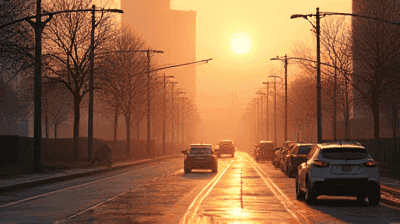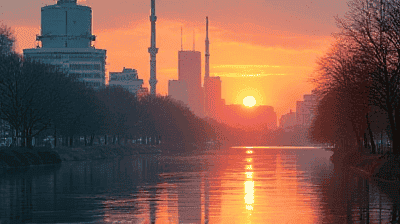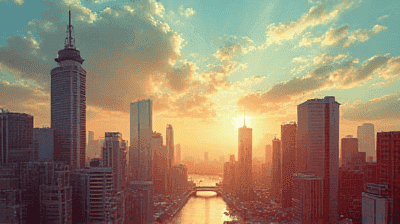
As urban areas continue to grow and develop, a concerning phenomenon known as the urban heat island effect has emerged. This effect not only impacts local climates but also poses significant challenges for public health, energy consumption, and sustainability. Understanding the causes, effects, and potential solutions to urban heat islands is essential for city planners, policymakers, and residents alike.
An urban heat island (UHI) is a localized area within a city or urban environment that experiences significantly higher temperatures than its surrounding rural areas. This temperature difference is primarily due to human activities and modifications of the landscape. The UHI effect is particularly pronounced during the summer months when urban temperatures can be several degrees warmer than those in nearby rural regions.
Several factors contribute to the formation of urban heat islands:
Land Cover Changes: Urbanization involves the replacement of natural vegetation with impervious surfaces such as concrete, asphalt, and buildings. These surfaces absorb and retain heat more effectively than soil and vegetation, leading to increased temperatures.
Reduced Vegetation: Urban areas often have less vegetation compared to rural areas. Trees and plants provide shade and release moisture through a process called transpiration, both of which help cool the environment. The loss of vegetation in cities exacerbates the UHI effect.
Heat Generated by Human Activities: Human activities such as transportation, industrial processes, and energy use contribute to increased temperatures. Vehicles, machinery, and power plants release heat, which accumulates in urban areas.
Waste Heat Emissions: Buildings, particularly those with heavy air conditioning usage, release waste heat into the atmosphere. This heat contributes to localized warming, especially during peak energy usage times.
Building Materials: The materials used in urban construction absorb and retain heat. For instance, dark roofs and pavements can significantly increase heat absorption, contributing to higher surface temperatures.
Geographical Location: Urban areas located in certain climatic zones, such as arid or semi-arid regions, may experience more pronounced UHI effects due to lower moisture levels and higher overall temperatures.
The urban heat island effect can be measured using various methods and tools. The most common approaches include:
Remote Sensing: Satellite imagery allows for the observation of surface temperatures across extensive areas. Thermal infrared sensors can capture temperature variations between urban and rural areas, providing valuable data on the extent of UHI.
Ground-Based Measurements: Weather stations placed throughout urban and rural areas can provide localized temperature readings. These measurements help determine the temperature differences between different land uses.
Modeling Techniques: Computational models can simulate the interactions between urban structures, vegetation, and meteorological conditions. These models can predict UHI patterns and assess the impact of potential interventions.

The consequences of urban heat islands are profound and wide-ranging, impacting various aspects of urban life:
The elevated temperatures associated with UHIs can have significant health implications, especially during heat waves. Some of the key public health effects include:
Heat-Related Illnesses: Higher temperatures increase the risk of heat exhaustion, heatstroke, and other heat-related illnesses, particularly for vulnerable populations such as the elderly, children, and individuals with pre-existing health conditions.
Respiratory Issues: Increased temperatures can exacerbate air pollution levels, leading to higher concentrations of ozone and particulate matter. This can worsen respiratory issues such as asthma and chronic obstructive pulmonary disease (COPD).
Mental Health Strain: Prolonged exposure to heat can impact mental well-being, increasing stress and anxiety levels among residents.
The economic implications of urban heat islands are significant and multifaceted:
Increased Energy Consumption: Higher temperatures lead to increased demand for air conditioning and cooling systems, resulting in higher energy costs and peak load on power grids.
Infrastructure Strain: The excess heat can accelerate the deterioration of infrastructure, including roads and buildings. Increased maintenance and repair costs are an inevitable consequence.
Reduced Agricultural Productivity: Urban heat islands can extend into surrounding agricultural areas, impacting crop yields and food security.
The environmental repercussions of UHIs are equally concerning:
Biodiversity Loss: Altered temperatures and reduced vegetation can affect local ecosystems, leading to habitat loss for various plant and animal species.
Water Quality Deterioration: Increased stormwater runoff due to impervious surfaces can lead to water quality issues in adjacent waterways, contributing to pollution and habitat degradation.
Altered Microclimates: UHIs can disrupt local weather patterns, leading to changes in precipitation and moisture levels that affect agriculture and natural ecosystems.
The impacts of urban heat islands often disproportionately affect marginalized communities, exacerbating social inequities:
Vulnerability of Low-Income Neighborhoods: Low-income neighborhoods may have less access to shade and green spaces, making them more susceptible to the adverse effects of heat.
Limited Resources for Mitigation: Communities lacking financial resources may struggle to invest in cooling solutions or improvements in infrastructure, perpetuating cycles of vulnerability.
Given the significant impacts of urban heat islands, it is essential to explore effective cooling solutions. A multi-faceted approach that involves community participation, policy intervention, and innovative design strategies can help mitigate the UHI effect.
Integrating more green spaces into urban environments is one of the most effective ways to combat the urban heat island effect. Some strategies include:
Urban Forests: Planting trees in urban areas provides shade, reduces heat absorption by surfaces, and enhances air quality through improved carbon sequestration.
Green Roofs: Installing vegetation on rooftops helps insulate buildings, absorb rainfall, and lower surrounding temperatures through evapotranspiration.
Community Gardens: Encouraging community gardens can enhance local food production while providing green space for residents to enjoy.
Parks and Recreation Areas: Developing more parks and recreation spaces allows residents to escape the heat and can provide crucial ecosystem services.
Cool roofs, designed to reflect more sunlight and absorb less heat, can significantly mitigate UHI effects. Key features include:
Reflective Coatings: Applying reflective coatings or materials to existing roofs can lower surface temperatures by reflecting sunlight away from the building.
Green Roof Integration: Incorporating greenery into roof designs can further enhance cooling benefits while providing aesthetic value.
Replacing impermeable surfaces with permeable materials can help manage stormwater while reducing temperatures. Options include:
Permeable Pavements: Installing permeable paving materials allows for better water infiltration, reducing heat absorption and providing cooler surface temperatures.
Rain Gardens: Designing rain gardens that collect runoff can help cool the area and promote biodiversity by providing habitat for various species.
Sustainable urban planning can play a crucial role in reducing the UHI effect. Key principles include:
Mixed-Use Development: Promoting mixed-use neighborhoods decreases the need for long commutes and encourages walkability, which can limit heat generated from transportation.
Zoning Regulations: Implementing zoning regulations that prioritize green space and set limits on the development of impervious surfaces can enhance overall urban resilience.
Transit-Oriented Development: Encouraging development around public transportation hubs can reduce dependence on personal vehicles, lowering overall heat generation.
Building design can influence local temperatures and energy consumption. Important measures include:
Energy-Efficient Building Materials: Utilizing materials with better insulation properties can help maintain comfortable indoor temperatures while reducing reliance on cooling systems.
Strategic Orientation: Designing buildings with appropriate solar orientation can minimize heat gain during peak sunlight hours.
Establishing innovative cooling programs can help communities address heat challenges more effectively:
Cooling Centers: Creating designated cooling centers during heat waves can provide safe spaces for vulnerable populations to escape the heat.
Public Awareness Campaigns: Educating residents about the risks associated with extreme heat and promoting cooling strategies can empower communities to take proactive measures.
Governments can implement policies and regulations to support cooling initiatives:
Heat Action Plans: Developing comprehensive heat action plans that outline strategies for reducing heat vulnerability can help communities prepare for extreme heat events.
Incentives for Green Infrastructure: Providing incentives for businesses and homeowners to implement green infrastructure solutions can stimulate community engagement and investment.
Ongoing research and technological advancements can yield new tools and methods for addressing urban heat islands:
Climate Modeling: Conducting research on climate modeling can help predict future temperature scenarios and assess the effectiveness of various interventions.
Smart Technology Integration: Utilizing smart technologies to monitor temperature trends and provide real-time data can enhance adaptive management strategies.

Examining successful implementations of urban heat island mitigation strategies can offer valuable insights and inspiration for other communities:
New York City has made significant strides in addressing the UHI effect through its CoolRoofs initiative:
CoolRoofs Program: This program promotes the installation of reflective roofing surfaces across the city, resulting in lower rooftop temperatures and energy savings.
Urban Forestry Programs: Efforts to increase tree canopy cover in underserved neighborhoods have also been prioritized, improving public health and livability.
Melbourne has taken a comprehensive approach to urban heat mitigation through its Urban Forest Strategy:
Targeted Tree Planting: The strategy aims to increase canopy cover across the city, particularly in areas most affected by heat, providing shade and cooling benefits.
Cool Streets Initiative: Implementing cool pavement technology has helped lower surface temperatures and improve local air quality.
Tokyo has implemented various cooling measures to address the UHI effect, focusing on community engagement and education:
Green Spaces Expansion: Efforts to expand parks and green spaces have helped mitigate heat and enhance biodiversity.
Public Awareness Campaigns: Tokyo has conducted campaigns to educate citizens about heat risks and encourage the use of public transportation.
The urban heat island effect is a pressing issue that affects countless communities around the world, with significant implications for public health, economy, and the environment. However, through understanding its causes and effects, cities can implement effective cooling solutions to combat the impacts of urban heat islands.
From increasing urban green spaces to promoting innovative building designs and community involvement, there are numerous strategies available to mitigate the UHI effect. Collaboration among government authorities, communities, and urban planners is essential to develop sustainable and effective solutions that prioritize public well-being and environmental resilience.
As cities continue to grow and climate change intensifies, proactive measures to address urban heat islands will become more critical than ever. By embracing a multi-faceted approach, communities can thrive in increasingly challenging conditions while contributing to a sustainable and livable future.